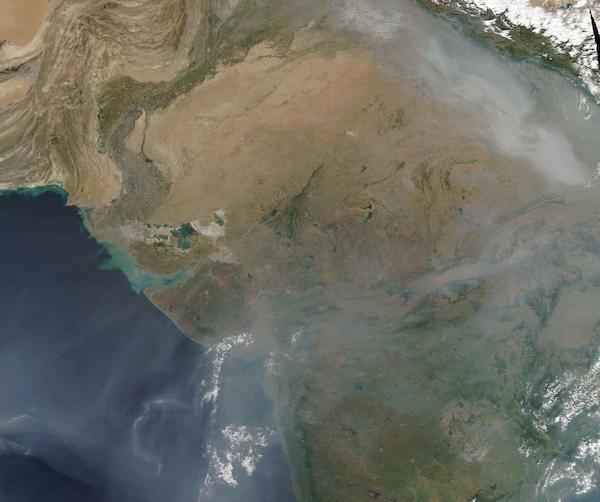Images
November 3, 2020 - Smoke and Haze across India
Tweet
On November 2, 2020, the Moderate Resolution Imaging Spectroradiometer (MODIS) on board NASA’s Aqua satellite acquired a true-color image of a river of smoke and haze pouring across northern India at the foot of the Himalayas and curving to the south and west to cover Mumbai, a large city on the western coast.
At the top of the image, a dense cloud of light gray marks plumes of smoke rising from numerous fires burning in the rich agricultural land of north-western India and north-eastern Pakistan. This area is a fertile alluvial plain which supports widespread farming as its economic base. In the autumn, as crops are harvested and the remaining vegetation dries, traditional farming practice turns to fire to clear the stubble and prepare fields for future planting. While stubble-burning has been banned in much of India – primarily because of the impact on air quality - many farmers still use the practice. As stubble-burning increases each fall, smoke frequently travels along the Himalayas and spreads hundreds, or sometimes thousands, of miles.
While it may seem logical to blame the fires for the haze that hangs across much of India, agricultural smoke is just one contributor to the country’s air quality woes. Other sources of the haze include India’s cities, industry, and automobiles. The haze is particularly thick over Mumbai, on the western coast, as well as Delhi, which is located east of the area of the rising smoke plumes.
The amount of haze and the primary location along the base of the mountains suggests that a temperature inversion also plays a role in the gray skies. It is common to see dense haze in northern India, Nepal, and Bangladesh in the winter, when cool air comes to the region. In normal conditions, air near the ground is warmer than the air above the ground. Warm air rises, and as it does so it carries the pollution upward where it eventually disperses when mixed with cooler air high above the ground. When cold temperatures come to the Himalayas, frigid air pours down the mountains and onto the plains. This makes the air near the ground colder than the layer of air above. The warm layer creates a lid over the cold air, which cannot rise through the warmth. Any smoke or other pollution captured in the cold air remain trapped as well, with no way to disperse. Extensive haze has been lingering over much of India, especially at the base of the Himalayas, since October 11.
Image Facts
Satellite:
Aqua
Date Acquired: 11/2/2020
Resolutions:
1km (313.1 KB), 500m (1.1 MB), 250m (3.8 MB)
Bands Used: 1,4,3
Image Credit:
MODIS Land Rapid Response Team, NASA GSFC
Tweet
On November 2, 2020, the Moderate Resolution Imaging Spectroradiometer (MODIS) on board NASA’s Aqua satellite acquired a true-color image of a river of smoke and haze pouring across northern India at the foot of the Himalayas and curving to the south and west to cover Mumbai, a large city on the western coast.
At the top of the image, a dense cloud of light gray marks plumes of smoke rising from numerous fires burning in the rich agricultural land of north-western India and north-eastern Pakistan. This area is a fertile alluvial plain which supports widespread farming as its economic base. In the autumn, as crops are harvested and the remaining vegetation dries, traditional farming practice turns to fire to clear the stubble and prepare fields for future planting. While stubble-burning has been banned in much of India – primarily because of the impact on air quality - many farmers still use the practice. As stubble-burning increases each fall, smoke frequently travels along the Himalayas and spreads hundreds, or sometimes thousands, of miles.
While it may seem logical to blame the fires for the haze that hangs across much of India, agricultural smoke is just one contributor to the country’s air quality woes. Other sources of the haze include India’s cities, industry, and automobiles. The haze is particularly thick over Mumbai, on the western coast, as well as Delhi, which is located east of the area of the rising smoke plumes.
The amount of haze and the primary location along the base of the mountains suggests that a temperature inversion also plays a role in the gray skies. It is common to see dense haze in northern India, Nepal, and Bangladesh in the winter, when cool air comes to the region. In normal conditions, air near the ground is warmer than the air above the ground. Warm air rises, and as it does so it carries the pollution upward where it eventually disperses when mixed with cooler air high above the ground. When cold temperatures come to the Himalayas, frigid air pours down the mountains and onto the plains. This makes the air near the ground colder than the layer of air above. The warm layer creates a lid over the cold air, which cannot rise through the warmth. Any smoke or other pollution captured in the cold air remain trapped as well, with no way to disperse. Extensive haze has been lingering over much of India, especially at the base of the Himalayas, since October 11.
Image Facts
Satellite:
Aqua
Date Acquired: 11/2/2020
Resolutions:
1km (313.1 KB), 500m (1.1 MB), 250m (3.8 MB)
Bands Used: 1,4,3
Image Credit:
MODIS Land Rapid Response Team, NASA GSFC




